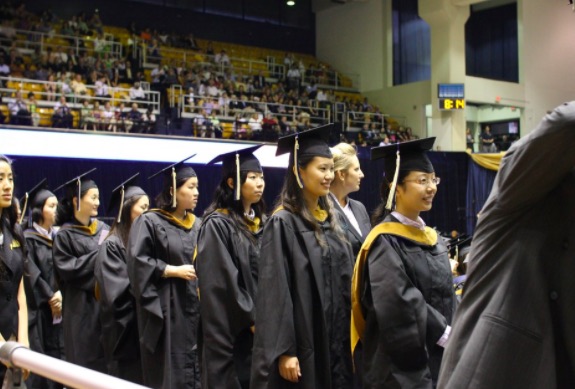
By Allen Baker
President Donald Trump’s belligerence toward China and his administration’s heartless and ill-thought-out Executive order to throw out foreign college students whose colleges, for health reasons, opt for another semester of on-line classes, could cast another wrench into the already clanking engine of the US economy.
US colleges enroll around 1.1 million foreign students, who spend billions of dollars on college tuition and other expenses.
How much economic impact does that involve?
Somewhere around $45 billion a year, according to a somewhat-dated (2018) number from the Institute of International Education, which got a grant for the study from the US State Department. The IIE is also the source for the 1.1 million students number, which is for the 2018-2019 school year.
Bringing in foreign students helps reduce the cavernous US trade deficit, and the contribution isn’t minuscule. That $45 billion represents 7.7 percent of the $498 billion US current account deficit for last year.
For US colleges, the continuing loss of high-revenue foreign students (most foreign students are full-payers, not major scholarship recipients) is a serious drain on their budgets, already devastated by the Pandemic and declining domestic enrollment.
Foreign students represent 5.5 percent of total US college enrollment, but they generally pay the highest tuition rates (no in-state tuition for them!), so their share of college revenues is much higher than the 5.5 percent figure. They’re likely paying double, or more, what US students pay. They also are highly represented in graduate programs, where tuition can be even heftier.
Higher education is a bigger part of the overall economy than you might think. Colleges collected $671 billion in revenues for the 2017-18 school year, according to the National Center for Education Statistics. That amounted to 3.2 percent of 2018 gross domestic product, and about 4 million jobs, a similar percentage of the work force —— at least before the virus epidemic.
And don’t forget: Along with tuition payments, foreign students spend money on housing, food, transportation and pizza.
Trump’s xenophobic rhetoric, especially against islamic and “shithole” countries, already had an impact on foreign student populations and those students’ contribution to the US economy. Don’t forget the tightening of visa rules and red tape in general.
In the school year right after Trump’s election (2017-2018), new enrollments of foreign students plunged by 6.6 percent. There was a further decline of 0.9 percent in the 2018-2019 period, according to State Department numbers, followed by a tiny increase of 0.05 percent last year.
Some foreign researchers, long coveted by China and other nations, also have chosen to leave the U.S after multiple controversies, investigations by the Federal Bureau of Investigation and pressure from government agencies that fund research projects. It might be worth recalling here that the father of China’s nuclear bomb, Qian Xuesen, who came to the US to study aeronautical engineering at MIT, went on to work at the Manhattan Project and in 1949 became head of Cal Tech’s Jed Propulsion Laboratory. In 1950, he was attacked and hounded by Sen. Joe McCarthy because of his former nationality and because of a house party he had attended in the late 1930s. When his security clearance was removed despite protests from his many US colleagues, jeopardizing his academic career, Qian tried to return to China. Detained and jailed for five years by the US on no charges, he was finally traded for some US pilots captured during the Korean War. Deported to the US to his native country, he spearheaded the development of that China’s intercontinental missiles and space program. (Navy Secretary Dan Kimball at the time called his arrest and later deportation, “The stupidest thing the US ever did — he was no more a Communist than I was and we forced him to go.”)
Foreign applicants accepted into US universities arguably are among the most promising students among those coming to this country, and more than half of them come to pursue studies in math, sciences, technology and engineering. At many US universities, foreign students account for 40-50% of those receiving STEM graduate diplomas each year. Many of these graduates are quickly snapped up by top Silicon Valley employers and other companies in the technology field, though government restrictions as well as sketchy prosecutions for alleged poaching of trade secrets and spying under the Trump Administration have made that process increasingly fraught and onerous.
Meanwhile, the upward-ratcheting pressure of US sanctions, government contracting rules and all the rest may lead the Chinese government to decide to keep its students home. That’s assuming they could otherwise actually fly into the US anyway, which, given Trump’s punitive and scientifically unjustified travel bans, might decide to bar them from entry.
Chinese university students are typically the biggest contingent of foreign students each year, representing a third of the US total.
With college sports programs curtailed or shut down, profitable dorms sitting empty, and online programs showing uneven success, your typical princely-compensated university administrator could be feeling a bit nervous already.
Loss of the profitable “full-payers from China” and other foreign students on top of that could lead to dozens of colleges literally shutting their doors, throwing more workers into a crowded jobless pool, while leaving research-hungry tech firms paying top dollar to lure already employed scientists and engineers from abroad, or trying to make do with less qualified American graduates — if they can find them.
ALLEN BAKER is a long-time journalist who has specialized in investigative pieces and economic analysis. He worked for the Associated Press in Alaska, for the St. Louis Post-Dispatch, and for several community newspapers and other publications. A resident of Ashland, OR, he contributed this article to ThisCantBeHappening.net
